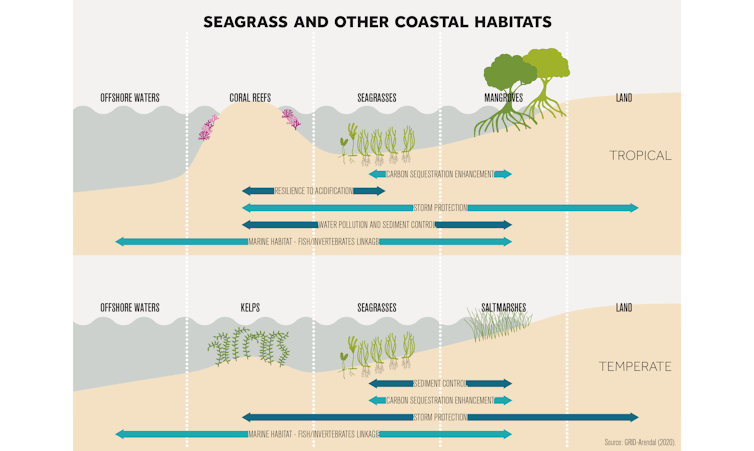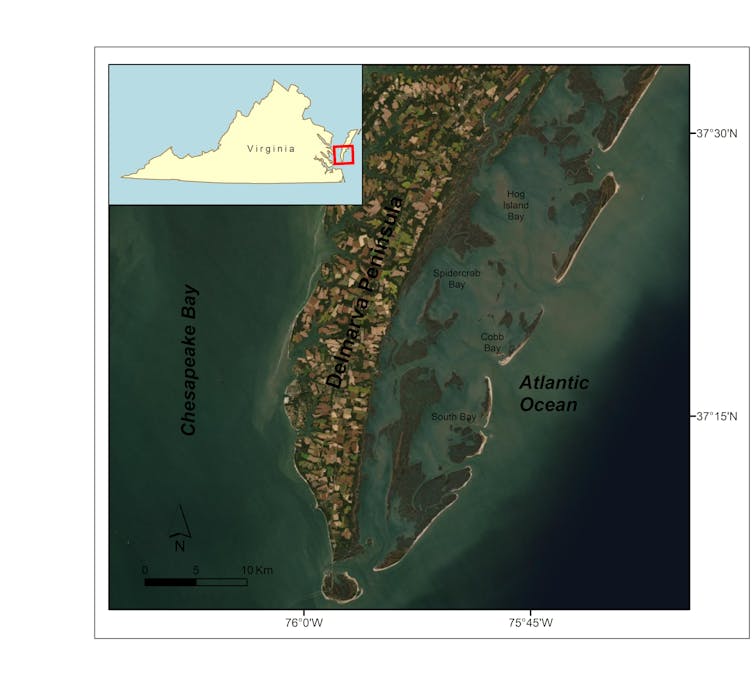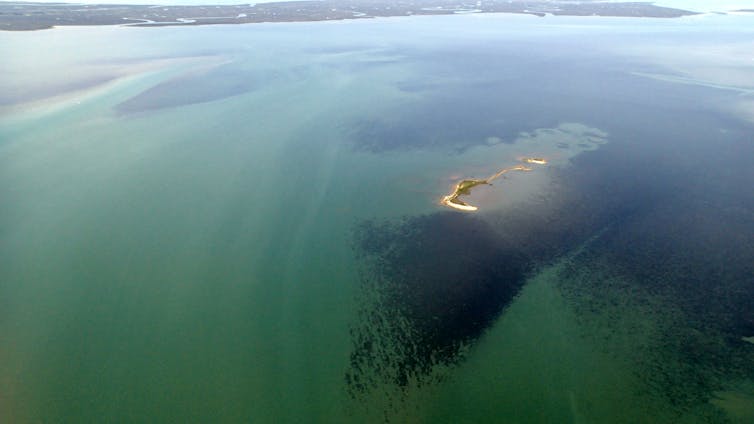Robert J. Orth, Virginia Institute of Marine Science; Jonathan Lefcheck, Smithsonian Institution, and Karen McGlathery, University of Virginia
A century in the past Virginia’s coastal lagoons have been a pure paradise. Fishing boats bobbed on the waves as geese flocked overhead. Beneath the floor, miles of seagrass gently swayed within the surf, making the seabed appear to be an enormous underwater prairie.
More than 70 species of seagrasses develop in shallow waters world wide, on each continent besides Antarctica. In Virginia, beds of eelgrass (Zostera marina) supplied habitat for bay scallops and meals for birds, and stored barrier islands from washing away. Eelgrass was so widespread that individuals who lived close to the shore packed and baled it to use as insulation for houses, faculties and hospitals.
In the Nineteen Thirties, nonetheless, pandemic plant illness and repeated hurricanes eradicated the eelgrass alongside Virginia’s japanese shore. The once-vibrant seafloor turned barren mud, main to a lack of “wildfowl, the cream of salt-water fishing, most of the clams and crabs, and all of the bay scallops,” sportsman and writer Eugene V. Connett wrote in 1947.
We are marine scientists who research seagrasses, marine biodiversity and coastal ecosystems. In a newly printed research, we describe the outcomes of a 20-year mission to reintroduce eelgrass into Virginia coastal bays utilizing a novel seed-based approach.
This mission has now restored 9,600 acres of seagrasses throughout 4 bays – probably the most profitable marine restoration efforts anyplace on the earth. It has triggered giant will increase in fishes and invertebrates, made the water clearer and trapped giant portions of carbon in seafloor sediments, serving to to sluggish local weather change. We see this work as a blueprint for restoring and sustaining wholesome ecosystems alongside coastlines world wide.

Why didn’t seagrasses get well naturally?
Development, nutrient runoff and different human impacts have broken marshes, mangroves, coral reefs and seagrasses in lots of bays and estuaries worldwide. Loss or shrinkage of those key habitats has diminished industrial fisheries, elevated erosion, made coastlines extra weak to floods and storms and harmed many varieties of aquatic life. Rapid local weather change has compounded these results by means of rising global temperatures, extra frequent and severe storms and ocean acidification.
In the late Nineties, native residents advised two of us who’re longtime college students of seagrasses (Robert “JJ” Orth and Karen McGlathery) that that they had noticed small patches of eelgrass in shallow waters off Virginia’s japanese shore. For years the traditional view had been that seagrasses on this space had not recovered from the occasions of the Nineteen Thirties as a result of human actions had made the area inhospitable for them.
But research confirmed that water high quality in these coastal bays was comparatively good. This led us to discover a unique clarification: Seeds from wholesome seagrass populations elsewhere alongside the Atlantic coast merely weren’t reaching these remoted bays. Seagrasses are underwater flowering vegetation, so seeds are among the many predominant methods they reproduce and unfold to new environments.

Sowing a brand new crop
From our earlier research, we knew that when eelgrass seeds fall from the guardian plant, they sink to the ocean backside shortly and don’t transfer removed from the place they land. We additionally knew that these seeds don’t germinate till late fall or early winter. This meant that if we collected the seeds in spring, when eelgrass flowers, we might maintain them till the autumn, serving to them survive over the months in between.
We determined to strive reseeding eelgrass within the areas the place they have been lacking. Starting in 1999, we collected seeds by hand from underwater meadows in close by Chesapeake Bay – plucking the lengthy reproductive shoots, bringing them back to our laboratory and holding them in giant outside seawater tanks till they launched their seeds naturally. After about 10 years we began gathering the grasses utilizing a custom-built underwater “lawn mower” to accumulate many extra of the reproductive shoots than we might by hand.
In 2001 we sowed our first spherical by merely tossing seeds from a ship. Our first take a look at plots lined 28 acres of mud flats in waters 2 to 3 ft deep. Returning the next 12 months, we noticed new seedlings sprouting up.
Each 12 months since then, the Virginia Institute of Marine Science and the Nature Conservancy’s Virginia Coast Reserve, together with employees and college students from the University of Virginia, have led a group of scientists and residents to accumulate and seed a mixed 536 acres of naked backside in a number of coastal bays.
These preliminary plots took off and quickly expanded. By 2020 they lined 9,600 acres throughout 4 bays. Several elements helped them flourish. These bays are naturally flushed with cool, clear water from the Atlantic Ocean. And they lie off the tip of Virginia’s japanese shore, the place there’s little coastal growth. https://www.youtube.com/embed/K9NyfPLINtk?wmode=transparent&start=0 To restore eelgrasses to Virginia coastal bays, scientists collected grasses in different areas, harvested their seeds and unfold them by hand.
Sheltering marine life and storing carbon
Since eelgrass disappeared from these bays within the Nineteen Thirties, human understanding of seagrass ecosystems has advanced. Today individuals don’t pack their partitions filled with seagrass insulation however as a substitute worth completely different companies they supply, resembling habitat for fish and shellfish – together with many commercially and recreationally important species.
Scientists and authorities businesses even have acknowledged the significance of coastal techniques in capturing and storing so-called “blue carbon.” In reality, we now know that seagrasses represent a globally vital carbon sink. They are a key software for decreasing carbon dioxide within the environment and slowing climate change
[Deep knowledge, daily. Sign up for The Conversation’s newsletter.]
We are working to perceive the dear companies that our restored seagrass beds present. To our shock, fish and invertebrates returned inside only some years because the meadows expanded. These organisms have established intensive meals webs that embody species starting from tiny seahorses to 6-foot-long sandbar sharks.
Other advantages have been equally dramatic. Water within the bays grow to be clearer because the seagrass cover trapped floating particles and deposited them onto the underside, burying vital shares of carbon and nitrogen in sediments sure by the grasses’ roots. Our analysis is the primary to confirm the general internet carbon captured by seagrass, and is now getting used to challenge carbon offset credit that in flip create more funds for restoration.
One massive query was whether or not restoring seagrasses might make it attainable to bring back bay scallops, which as soon as generated thousands and thousands of {dollars} for the native financial system. Since bay scallops now not existed in Virginia, we obtained broodstock from North Carolina, which we’ve got reared and released annually since 2013. Regular surveys now reveal a rising inhabitants of bay scallops within the restored eelgrass, though there’s nonetheless a way to go earlier than they attain ranges seen within the Nineteen Thirties.

A mannequin for coastal restoration
Repairing broken ecosystems is such an pressing mission worldwide that the United Nations has designated 2021-2030 because the U.N. Decade on Ecosystem Restoration. We see the success we’ve got achieved with eelgrass restoration as a major mannequin for comparable efforts in coastal areas world wide.
Our mission targeted not solely on reviving this important habitat, but additionally on charting how restoring seagrasses affected the ecosystem and on the co-restoration of bay scallops. It offers a highway map for involving students, nonprofits organizations, residents and authorities businesses in an ecological mission the place they can see the outcomes of their work.
Recent assessments present that the restored zone solely covers about 30% of the full liveable backside in our mission space. With continued assist, eelgrass – and the numerous advantages it offers – might proceed to thrive and broaden properly into the twenty first century.
Robert J. Orth, Professor of Marine Science, Virginia Institute of Marine Science; Jonathan Lefcheck, Research Scientist, Smithsonian Environmental Research Center, Smithsonian Institution, and Karen McGlathery, Professor of Environmental Sciences and Director, Environmental Resilience Institute, University of Virginia
This article is republished from The Conversation beneath a Creative Commons license. Read the original article.







